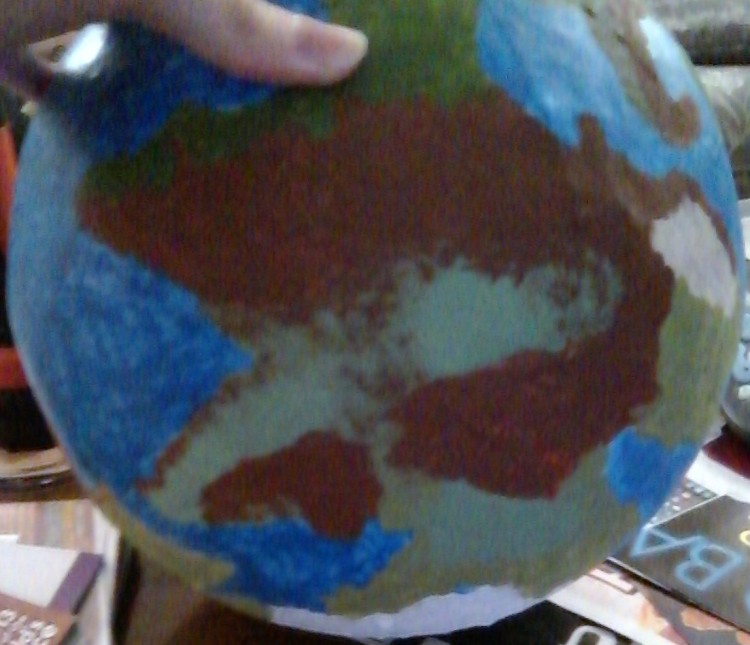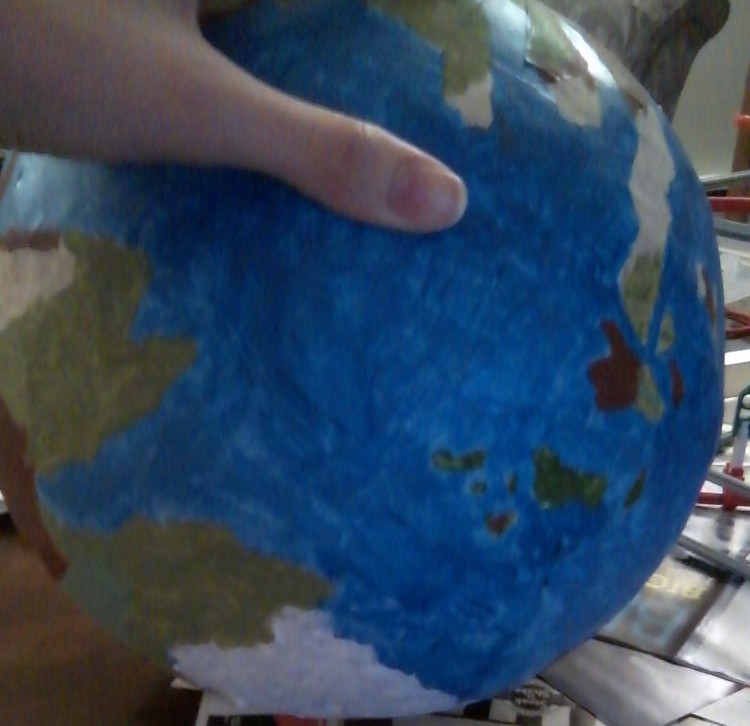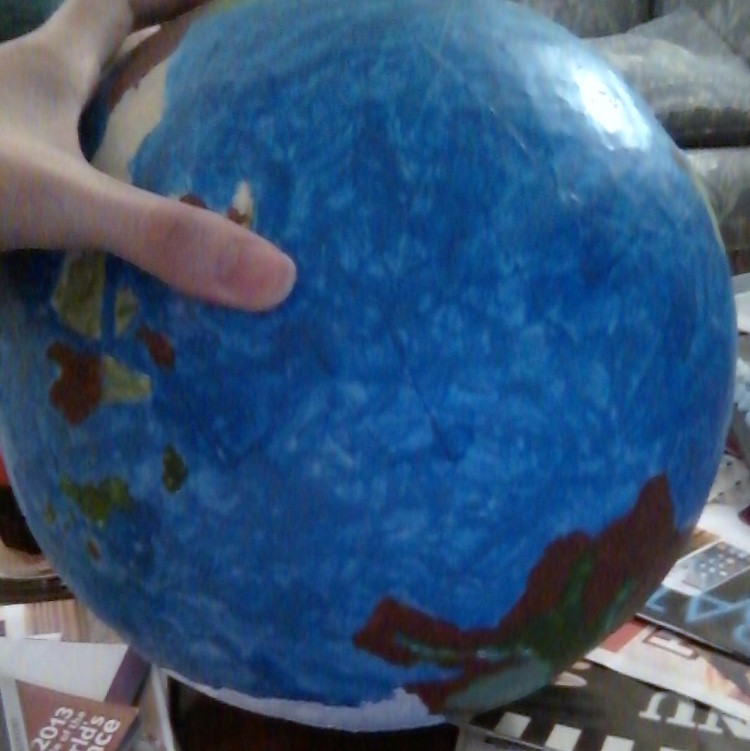Here is the final pictures of the paper mache project:
I apologize for the fuzzy aspect to the pictures. They were taken with my phone camera.
Also, I tilted the globe so you can see the north and south poles more clearly:
 I am looking down at the globe toward the northern hemisphere and the continent of Vera. To the east, you can see half of the continent of Ratomae — the desert on the western side of its continental divide. The continent of Vera is intersected by a mountain range, mostly due to the plate tectonics in that region. Also, most of it is covered in forest with deserts at the equator that intersects the southern peninsulas at the bottom of the image. The forests of Vera are huge, where the trees can grow to a kilometer tall in places. This is partly because Elivera is slightly smaller than Earth, and slightly less massive, which gives it a lower surface gravity. Other factors come into play to allow for the huge growth of the trees, but that’s already discussed in my world-building posts, so check those out for more information!
I am looking down at the globe toward the northern hemisphere and the continent of Vera. To the east, you can see half of the continent of Ratomae — the desert on the western side of its continental divide. The continent of Vera is intersected by a mountain range, mostly due to the plate tectonics in that region. Also, most of it is covered in forest with deserts at the equator that intersects the southern peninsulas at the bottom of the image. The forests of Vera are huge, where the trees can grow to a kilometer tall in places. This is partly because Elivera is slightly smaller than Earth, and slightly less massive, which gives it a lower surface gravity. Other factors come into play to allow for the huge growth of the trees, but that’s already discussed in my world-building posts, so check those out for more information!
 Here is the Isutobek islands. This is my first mistake: those islands are too large. They should be ten times smaller. Something to repair for my next attempt at this project.
Here is the Isutobek islands. This is my first mistake: those islands are too large. They should be ten times smaller. Something to repair for my next attempt at this project.
 The other side of the Isutobek islands (ugh! too big! But nearly impossible to fix after I painted them), and the rest of Ratomae, the eastern side of its continental divide. I also made sure to take this picture looking down on the eastern side of the northern hemisphere, that way you can get a good look at the northern ice cap. There is a continent under the northern ice cap, but there is nothing but ocean under the southern one.
The other side of the Isutobek islands (ugh! too big! But nearly impossible to fix after I painted them), and the rest of Ratomae, the eastern side of its continental divide. I also made sure to take this picture looking down on the eastern side of the northern hemisphere, that way you can get a good look at the northern ice cap. There is a continent under the northern ice cap, but there is nothing but ocean under the southern one.
 I put the globe on the table, and titled it so you could see the southern hemisphere better. This is the continent of Egoni. Here is my other minor error. The southern ice cap shouldn’t quite touch Egoni’s southern shore, but I drew it too far down and didn’t realize it until after I painted the ocean around it. It was too late to fix then. Also, note how mountains encircle the top and sides of the continent. There are huge, deep canyons in these mountains, and at the bottom of the canyons there is crevices and fissures, that lead to underground caverns. Winds blow through these canyons at upward of 200 km/hr, so if you’re in the canyon or near it, you can hear what sounds almost like musical notes. This is due to the winds hitting the fissures and the holes in the ground, similar to how you’d play a flute.
I put the globe on the table, and titled it so you could see the southern hemisphere better. This is the continent of Egoni. Here is my other minor error. The southern ice cap shouldn’t quite touch Egoni’s southern shore, but I drew it too far down and didn’t realize it until after I painted the ocean around it. It was too late to fix then. Also, note how mountains encircle the top and sides of the continent. There are huge, deep canyons in these mountains, and at the bottom of the canyons there is crevices and fissures, that lead to underground caverns. Winds blow through these canyons at upward of 200 km/hr, so if you’re in the canyon or near it, you can hear what sounds almost like musical notes. This is due to the winds hitting the fissures and the holes in the ground, similar to how you’d play a flute.
 Turned so you can see how close Egoni is to the continent of Kefutji.
Turned so you can see how close Egoni is to the continent of Kefutji.
 The continent of Kefutji, which is a highly mountainous region — a lot of tectonic movement in this area, not just collision of plates, but also lots of hot spots. There’s marshes, forests, and highlands as well as cold grasslands to the south. It’s probably the only continent on this planet with the most disparate climate zones.
The continent of Kefutji, which is a highly mountainous region — a lot of tectonic movement in this area, not just collision of plates, but also lots of hot spots. There’s marshes, forests, and highlands as well as cold grasslands to the south. It’s probably the only continent on this planet with the most disparate climate zones.
 I tipped the globe upward even more so you could see the entirety of the southern ice cap and how it overflows onto the southern shores of Kefutji. The globe is also tipped slightly to the reader’s left, so it’s not entirely straight up and down.
I tipped the globe upward even more so you could see the entirety of the southern ice cap and how it overflows onto the southern shores of Kefutji. The globe is also tipped slightly to the reader’s left, so it’s not entirely straight up and down.
 The ocean between Kefutji and the southern most peninsula of Vera.
The ocean between Kefutji and the southern most peninsula of Vera.
 The ocean between the southern tip of Vera and the start of Egoni. The globe is straight up and down at this point. No tipping at all, thus the equator should be in the center of this image.
The ocean between the southern tip of Vera and the start of Egoni. The globe is straight up and down at this point. No tipping at all, thus the equator should be in the center of this image.
And that’s it! It was a fun experiment. What I learned:
- Glue-based paper mache is simply not porous enough. It took multiple coats of acrylic paint to produce the color hues I needed. Also, the paint scrapes off easily, so I have to be very careful with its stand. I may take some fishing wire, create a slim net with it, and set the globe in that, so it can be hung and less chance of the paint being scraped.
- Styrofoam base for this is too scratchy and porous to handle paint, so something has to be layered atop it for this to work.
- Self-hardening clay is more porous than paper mache, so may try that as a possible fix.
It’s a relief to see it finished, and I must admit, it’s fun to show to others. For a first try, it turned out alright. Now I know what works and what doesn’t, and I have ideas on how to improve this project for when I try this again. My hope is to create a more detailed and better version of this planet, and then I’d like to create a model of its moons (both are fairly small), and a few planets in other solar systems that the people in my novels have colonized. It’ll probably take me quite awhile, but I’ll be sure to update here when I start on this. For the moment, I’ll return to some basic map-making with paper and pencils, and working on finishing some of my current writing projects.

Whoa! I finally see the project you were telling me about. Cool! Yeah, the beach ball I drew on was waaaay too big, so everything ended up on one side of the planet, and I didn’t know what to do with the other half of the ball.
Are you going to hang your planets from the ceiling, perhaps? Dude, that would rock! A miniature solar system overhead.
LikeLike